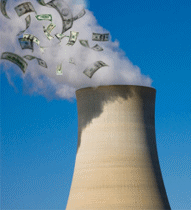In the months leading up to President Obama’s inauguration, the Bush administration rushed through a raft of controversial regulations. These “midnight regulations,” like the one that would allow mining waste to be dumped into rivers and streams in West Virginia, caused a major stir at the time — but whatever happened to them? After a year in office, has the new president been able to clean up his predecessor’s last minute mess? The answer is a mixed bag of attempts, delays, successes, and road blocks.
Among the avalanche of over 150 midnight regulations issued in the waning days of Bush’s tenure, there are several major environmental deregulations that make it easier for factory farms to pollute, endangered species to be threatened, and hazardous waste to be burned. Despite attempts by the current administration, almost all of these remain in effect.
Part of the reason for the holdup is that the outgoing Bush administration made a special effort to limit the incoming president’s ability to reverse these rules by finalizing them before handing the reins to Obama. This makes the rules very difficult to reverse even for a well intentioned successor. Changes or cancellations must go through the same extensive and politicized process as proposed rules themselves, so removing a bad rule can take years and success is not guaranteed.
The Obama administration froze pending regulations where possible — Rahm Emmanuel issued a memo within hours of the inauguration which stopped all rulemaking. He also asked agencies to consider delaying the effective date of the rules if they were already published. But once the regulations are on the books — as many of Bush’s last minute regulations were — they cannot be withdrawn unilaterally.
Here is how the White House and its allies are making progress on overturning nine high profile environmental midnight regulations:
Congress
In one case, the president successfully encouraged Congress to use appropriations measures to overturn a midnight regulation which weakened endangered species protections. Congressional actions are effective and binding, but trying to use this method to withdraw each of Bush’s last minute rules may not be politically feasible: other than riders in appropriations bills, only stand-alone legislation or the rarely used Congressional Review Act can strike down a bad midnight regulation. In this political climate, it is not likely that Obama will go back to the Hill for more help.
Courts
Three of these nine environmental regulations are being challenged in court by advocacy groups: the mountain top mining rule, a permissive oil shale drilling rule, and a deregulation for air pollution from factory farms. The challenges are all making slow and halting progress through the legal system.
While suits are pending, EPA has the authority to ask the courts to suspend the effective date of the rule, preventing it from being implemented in the meantime. It’s not clear why the agency has not done this yet for these rules. For example, the Obama administration pushed back the effective date to May 2010 for a midnight regulation that would no longer ask facilities to collect and report certain kinds of pollution emissions.
Slow or stalled
In two cases, administrative action to reverse midnight environmental rules has been slow. Only recently has the administration proposed rescinding a rule allowing the burning of hazardous waste. In addition, another bad rule — this one to weaken a standard governing recycling hazardous solid wastes — just begun the long path towards reversal. EPA opened a public comment period on proposed revisions, but no further action has been taken.
In another two cases, midnight regulations are on the books and seem likely to stand.: one, allowing concentrated animal feeding operations to self-regulate their own pollution, and another rule that makes it harder to limit the development of public lands.
Clearly there are many issues on the president’s plate that have prevented faster action to push back against these rules. That is why passing midnight regulations is an effective strategy: it forces a new president to make the choice between challenging the actions of a past administration and moving forward with a new agenda. Because they are drafting aggressive new regulation on greenhouse gases and other issues, the agencies have not been able to act decisively to overturn midnight regulations: there is only so much time in the day, and agency budgets are not exactly flush. But the tradeoff has been that the ghost of the last administration is still haunting us, carrying out an anti-environmental agenda well after it drew its last breath.



